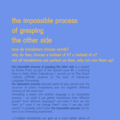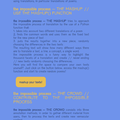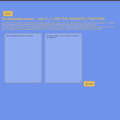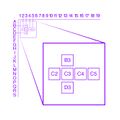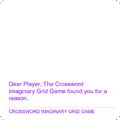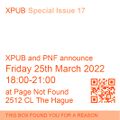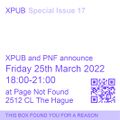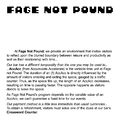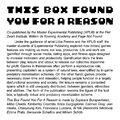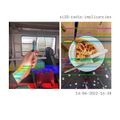User:FLEM/Final presentation: Difference between revisions
No edit summary |
|||
| Line 15: | Line 15: | ||
//multiple translations can give us a much better sense of the poem than a single translation can, so that even if we can’t read the poem in the original language, we can come closer to that experience° // the impossible process is made of two sections: one (THE CROWD) is to gather //vernacular// information and the other (THE MASHUP) is to process texts, which can be both taken from the vernacular content or from already existing translations. The poetry archive (work in progress) will showcase the results. | //multiple translations can give us a much better sense of the poem than a single translation can, so that even if we can’t read the poem in the original language, we can come closer to that experience° // the impossible process is made of two sections: one (THE CROWD) is to gather //vernacular// information and the other (THE MASHUP) is to process texts, which can be both taken from the vernacular content or from already existing translations. The poetry archive (work in progress) will showcase the results. | ||
[[File:Parallelrecordingexplanation.jpg|frameless|idea explanation]] | |||
=== Connection with second year project === | === Connection with second year project === | ||
Revision as of 11:04, 9 June 2023
Special issue 16
My main project during the special issue 16 was the impossible process project.
Wiki research & documentation: poems translations.
Website: https://hub.xpub.nl/soupboat/theimpossibleprocess/
the impossible process of grasping the other side
the impossible process of grasping the other side is a project by Emma Prato, as part of the Special Issue 16 //Learning How to Walk While Catwalking// carried out by Piet Zwart Institute (XPUB) students on the topic of Vernacular Language Processing.
the impossible process basically wants to play around with the structure of poetry translations and mix together different versions of the same text.
translating a poem into another language is an impossible process - so what if we gather translations from different people? from different languages? and what if then we mix them up? what if we change them? what if we play with words? it probably won't solve the impossible process but for sure is an interesting experiment.
//multiple translations can give us a much better sense of the poem than a single translation can, so that even if we can’t read the poem in the original language, we can come closer to that experience° // the impossible process is made of two sections: one (THE CROWD) is to gather //vernacular// information and the other (THE MASHUP) is to process texts, which can be both taken from the vernacular content or from already existing translations. The poetry archive (work in progress) will showcase the results.

Connection with second year project
In the SI16, I analysed patterns and disrupted common structures to create new versions of texts. I created a prototype of linguistic patterns and the impossible project website, a tool for vernacular translations. Plus, I used the annotation system created for Special Issue 16 to gather translations from users. The final publication for the public to interact and understand the Python function I created has been the "letter bag", an activity that would reproduce what happens in the function and ask the user to do it by hand. In recalls what I am making in the Second Year project with the following question: what happens when you mirror digital interactions into a physical movement? In both cases, I reckon, it is a very interesting tool to make people who know nothing about coding, what is happening.
I started to understand how python scripts work and started making some website to try out things.
Contribution/groups
- I was part of ADMIN TEAM: creating the meetings, schedules, keeping track of the work.
- I was part of LAUNCH TEAM: event coordination, organisation and user experience for the launch day.
- I was part of FRONT-END TEAM: support during the creation of front-end of the website, advices and considerations.
- Content group: research on python function, set up, layout and flask for website of “the impossible process”; prints and booklet for the same project. In addition, general research for the “vernacular maps” group.
Side things
My notes documentation: User:FLEM/1.1
- collabweek3
- Station Skill html
- text waving
- transcription
- smart textile station skill
- wood station skill
- jacques prévert poems
Gallery
Special issue 17
The crossword experience
The crossword experience is a reference to the crosswords as well as an overview of the productive play glossary, that will be found inside the loot box and represents the research part of our project. The post-its/squared pieces of paper definitions act as a go-between the content and the players, and obviously share the values and reasons why post-its have been chosen as the mean for this project. The idea emerged to reflect on some of our main topics (slow-thinking, delayed rewarding, gamification processes, competition, individuality, productive environment) in a gamified way.
The player will:
1. Complete a puzzle to create a word, therefore to play a game to obtain a drink, instead of having a need and satisfying it immediately. It is a critic of loot boxes philosophy and serves to slow the pace down because the players can't get the drink immediately (delayed-reward and slow-thinking).
2. By the end of the event, the public will have produced a collective work, a big crossword made by everyone in the room. It's a way to create interaction and criticise the videogames world that produces a lot of individuality and competition. Instead, this method invites the player to embrace collectivity and inclusivity.
Wiki research & documentation: User:FLEM/Crosswords
Connection with second year project
Again, I always tried to involve a public, to explain more than what seems like needed, had in mind the idea that our public should understand and it has been underlined my intent of translating one form of research into an activity/event. One of the results of this has been the crosswords game, both for the launch day and for the publication. I like the idea that an audience can interact with what is shown to them: everyone has different learning methodologies, and it’s our job to put everyone in a situation where they can get the best out of the experience.
Contribution/groups
I did research and polished the glossary of productive play to transform it into a usable and understandable game for the public. A way to access our theoretical research through the use of gamification. The result was both presented inside the box as “The Crossword Imaginary Grid Game” and during the launch as “the Fage Not Pound Bar Counter”.
I was part of LAUNCH group: Price of the box, Texts for the launch, both documentation and presentation of the work, Prints and plotting, name tags, Plexiglas letter game for the launch.
Side things
My notes documentation: User:FLEM/1.2
- a box in a box in a box - 16_02_22 (with G&Carmen)
- Re-writing Station Skill
- Station Skill Java
- calligraphy and typography station skills
- the social side of games
- playing cards
- Glossary_of_productive_play
Gallery
Special issue 18
The SI18 structure gave more space for our personal interests, actions and reactions.
In the last trimester, we worked with notation systems, annotation methods and distributive practices, which grasped my interest quite a lot. Miriam and I, for the week02release, produced an instructional piece on “how to make sound”. The editorial proposals I have been part of are also significant: week5release was about collective writing, a practice that I find deeply interesting, and I was also interested in the idea of distributive practice (produce—>share—>exchange—>perform—>edit—>produce—>share—>..go on). As well as transcription methods that feed the need of experimenting with text (see Libretto of week3). While talking about instruments and tools, I worked on the Draggable, another online tool to mess up with texts (and audio in this case). The other editorial proposal was about folder and content nesting: the activation by users is essential for the functionality of the tool we curated for this release. The result was a collective process: the result will be obtained only if others will actively participate.
I enjoyed creating small weekly prototypes, and the possibility to try new things proposed by other people: the moment when I received the proposals and had to discover what it could be about. Then, seeing how my brain starts to work and looks for inventive solutions to learn and to try out different methods or tools. I am happy how I managed, as a caretaker, to go deeper into my personal interests, to see how contributors reacted to the proposals (7&5) and the possibility that my ideas will change after other people experimented with them or created their own way out of it. I am pleased to see how we could influence each other and evolve in very different ways with every method we've been using and the person we were working with. It all gave me the feeling of collective work.
Contribution/groups
Wiki research & documentation:
- week 02 ---> https://hub.xpub.nl/soupboat/SI18/02/recordings/your%20personal%20guide%20to%20making%20sound.mp3
- week 03 ---> audio file: ACT1 libretto: Within an entangled state
- week 05 ---> https://hub.xpub.nl/soupboat/~flem/FIVE_nested_narratives_active_listening.mp4 instrument: voiced drum machine; audio piece: what-is-right-not-to.mp3 text: what-is-right-not-to.txt ---> The Drag-able
Side things
My notes documentation: User:FLEM/1.3
Gallery
Second Year
wikis:
User:FLEM/Analysis of sessions
Thesis & Research
Last year I started questioning my notebook's practice and tried to build a new paper device that would satisfy better the needs of my brain in that moment. To get there I asked myself what were the problems in the device I was using and how changing something small could already improve my use of the notebook. I then wondered: "Why are we all using a device with the same structure? And what impact does it have on our learning, thinking and living, as well as on the imaginary of self? And how creating our personal tools would help users to understand better themselves and their needs?".
I believe this is really a personal matter and that every individual should or could find their personal answers to this. How can I, through research and explorative sessions, discover more about the topic and create a generative structure that can be interpreted by every person in their own way to promote creativity and self-expression?
The thesis is a report of my practice: informed through theoretical research and references that will feed the research method section that will then be part of the body of the thesis.
Abstract: Paper Notebooks: From an Industrial Model to a Tool of Expression is an ongoing research project that attempts to understand how the structure, shape and functionality of a paper notebook can influence the way we take notes as well as the frequency and efficiency of use. The thesis uses theoretical research and practical methodologies to analyse paper notebooks, to discover how different prompts and activities can change the users’ mindset and consciousness, while inviting them to produce personalised DIY notebooks in their personal practice.
The research methods used to feed this thesis are multiple. The first one is my personal notebook process that consists in the creation of different prototypes to analyse and question my use of notebooks and to discover how to modify them to adjust them to my needs. The second method is discussion groups to collect opinions through conversation and questions. The third one involves gathering and analysing the work of other users to understand how they approach the same process. The last method is the Collaborative Explorative Sessions (C.E.S.): the C.E.S. are a collaborative playground to experiment with a collection of exercises together with the workshop participants. I created the C.E.S. through the knowledge acquired in the process and specifically thanks to the first three methods included in the research, as well as inspired by Generative Design Research, which includes the end user in the design process (Sanders and Stappers, 2014). The text charts a historical and contextual overview on notebooks, the development of the project and presents findings that will lead to the creation of a physical outcome. This will take the shape of a guide or kick-starter kit to help others to analyse their own practice and to start questioning it, as well as to encourage a hands-on approach.
User:FLEM/Analysis of sessions:
NOTEBOOKS PROTOTYPES
This research begun when I finished my notebook and started a plan to build up a new one. The idea came out from the measurements of the design of an Italian publishing house (Iperborea) I really love: 10x20 cm. The issue was that, by starting from an A4 paper, I would have been obliged to cut out a lot of paper and therefore, I decided that I didn’t want to create a new notebook out of that idea without finding a solution that would not waste anything. I then produced different prototypes to play around with the concept of adapting notebooks to my needs.
At this point, I tried to distribute notebooks prototypes around and realised how it was not possible that I would create the notebooks My classmates started experimenting with their own and I saw what was happening was much more interesting than me looking for a perfect notebook, that obviously does not exist as our needs change depending on who we are and in which situation we need the object.
PREPARATORY SESSIONS
I organised three preparatory sessions in which I brought up specific questions and discussed them together with the participants. The main aim of these sessions was to discover if notebooks are part of their lives and if I could use this specific object to incite a certain type of thoughts and associations to promote self-expression and creativity.
C.E.S.
As the first practical session, my aim was to experiment with different activities to help participants to imagine the iterative process to arrive to a notebook. It was important, at this point, to transform my questions into practice. We went through 3 practical exercises and then everyone made a notebook based on their discoveries.
FUTURE
The idea for the future is to organise more sessions, to try out different structures and exercises. I plan to work on a website that can gather the information on the past sessions, on the new prototypes, on new ideas and work as an invitation to join the process of discovery of the (un)perfect notebook.
The publication and plans for the grad show
The printed publication & website
final work: starting from the question on how can I edit and present all of this material I gathered in the last year. I wanted to share all the little discoveries I made and what I learnt with others. The choice of the cards come together with the consciousness of how hard it is for reader to follow such a long research and using my knowledge of notebooks structures and explorations to find a fitting solution. The notebook I created and experimented on myself in November 2022 (the notebook kit), provides a special feature "It has been helpful to re-organise thoughts in very small sheets of paper. This obliged me to describe a concept in a little amount of words". By dividing the concepts and information in small pieces and by transforming the medium into an interactive activity, that allows personalisation and modularity, i invite users of this publication-game to explore the concepts at their own pace. In addition, the concept of modularity participated widely also thanks to the concept of index cards: "Secondo Lancellotti (1583–1643) created an index system in which he would insert “associative cross-references and pointers whenever and wherever possible, enabling the reader to surf through” all these annotations, “replacing reading with a type of early modern hypertext” (Cevolini, 2020).
Write in the presentation that in the notebook book there are also information and discussions on how to write where to write and questions on how it makes a difference also the notetaking practice when approaching different interfaces
The grad show
22.05.23
little gift idea
this specific little notebook that i gifted kim and chae for the midwives work showed itself to work for specific activities: writing letters, free-writing, getting rid of thoughts very fast let's say. We discussed in class that we are going to have a shop were we can sell little things and i was thinking about selling them for a *on offer* price as i am making them with 0 expenses as it's all leftover materials. It would be nice maybe, to have a table with them and then other materials so if someone wants they can come and make them. Maybe, i would not even need to prepare them beforehand but bind them directly on the spot in my area and if someone is interested in receiving a little gift to help them to write a lotttttttttt they can get it here. It's also a way to give an example of what you can do with 0 money. And would it be fun or awkward to say if you make it yourself it's for free and if you just want to get it you pay a little for my working time (that it's still very limited). Talking about the price of work, and how people can experiment with this shape and make them a tiny different from my version... mmm i like it, it doesn't have to be a CES, but sort of. And maybe with the making there'll be some chatting and that's all.
A sort of notebook that can be used if you need to write letters, get rid of thoughts, write fast, brainstorm for projects or writing tasks, see what happens. Maybe add the print of the ones I gave chae and kim for context. + comment from mitsa during CES (so narrow make me think i can write down without thinking). If you do not know what to start with, there it is. And in case, you can also gift it to someone!
the grad show shelves team
Side things
Gallery
General side things
- worked for V2, Worm, Mama and art and music festival (Conflux, Rewire Festival) as a host since January 2022
- worked as a archipelago member and designed and risoprinted 4 newspaper The Piet, as well as organised a series of events and workshops.


